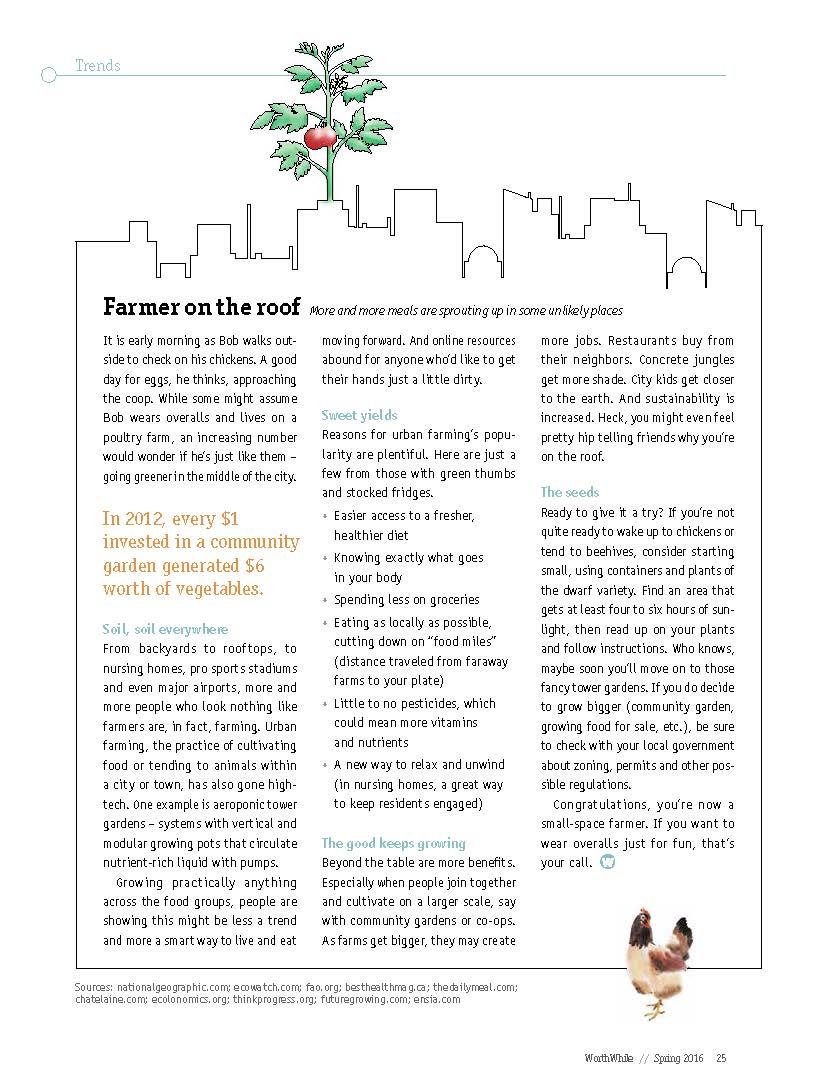Features
Trends Feature: Urban Farming
Article for WorthWhile magazine shining a little sunlight on growing food within cities and towns.
WorthWhile is a quarterly publication from Raymond James Financial.

View Copy
It is early morning as Bob walks outside to check on his chickens. A good day for eggs, he thinks, approaching the coop. While some might assume Bob wears overalls and lives on a poultry farm, an increasing number would wonder if he’s just like them – going greener in the middle of the city.
In 2012, every $1 invested in a community garden generated $6 worth of vegetables.
Soil, soil everywhere
From backyards to rooftops, to nursing homes, pro sports stadiums and even major airports, more and more people who look nothing like farmers are, in fact, farming. Urban farming, the practice of cultivating food or tending to animals within a city or town, has also gone high-tech. One example is aeroponic tower gardens – systems with vertical and modular growing pots that circulate nutrient-rich liquid with pumps.
Growing practically anything across the food groups, people are showing this might be less a trend and more a smart way to live and eat moving forward. And online resources abound for anyone who’d like to get their hands just a little dirty.
Sweet yields
Reasons for urban farming’s popularity are plentiful. Here are just a few from those with green thumbs and stocked fridges.
• Easier access to a fresher, healthier diet
• Knowing exactly what goes in your body
• Spending less on groceries
• Eating as locally as possible, cutting down on “food miles” (distance traveled from faraway
• farms to your plate)
• Little to no pesticides, which could mean more vitamins and nutrients
• A new way to relax and unwind (in nursing homes, a great way to keep residents engaged)
The good keeps growing
Beyond the table are more benefits. Especially when people join together and cultivate on a larger scale, say with community gardens or co-ops. As farms get bigger, they may create more jobs. Restaurants buy from their neighbors. Concrete jungles get more shade. City kids get closer to the earth. And sustainability is increased. Heck, you might even feel pretty hip telling friends why you’re on the roof.
The seeds
Ready to give it a try? If you’re not quite ready to wake up to chickens or tend to beehives, consider starting small, using containers and plants of the dwarf variety. Find an area that gets at least four to six hours of sunlight, then read up on your plants and follow instructions. Who knows, maybe soon you’ll move on to those fancy tower gardens. If you do decide to grow bigger (community garden, growing food for sale, etc.), be sure to check with your local government about zoning, permits and other possible regulations.
Congratulations, you’re now a small-space farmer. If you want to wear overalls just for fun, that’s your call.